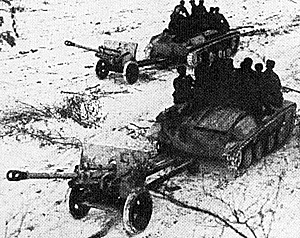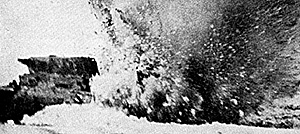In Operation Uranus, the Soviet high command exploited the untenable position of the German 6th Army by gripping it with several Soviet armies and simultaneously massing additional armies tailored to effect the first really successful Soviet operational advances of World War II -- the double envelopment of the Germans at Stalingrad.
 Russian anti-tank guns and crews moving forward
Russian anti-tank guns and crews moving forward
On 19 November 1942, the Soviets attacked with the 5th Tank Army and the 21st Army (comparable with very strong German corps-level organization) to surround Stalingrad from the northwest. One day later, on 20 November 1942, the Soviets attacked with the 51st and 57th Armies of the Stalingrad Front to surround the city from the south.
Along the fronts of those armies, the Soviets launched powerful attacks with infantry divisions supported by army and front artillery and by independent tank regiments and brigades. For the deep operational advances to surround the 6th Army, the Soviets concentrated one operational level group with the 5th Tank Army and another with the adjoining (to the east) 21st Army to make the advance to Kalach in the rear of the 6th Army. The Soviet mobile groups included the 1st and 26th Tank Corps and 8th Cavalry Corps in the 5th Tank Army. The latter army advanced with the 1st Tank Corps up against the lower reaches of the left (north) bank of the Chir River where it would soon be joined by strong infantry and artillery forces.
On 23 November 1942, the Soviets completed the encirclement
of the 6th Army by linking up at Sovetsky, 10 miles east of Kalach on
the Don. [11]
At approximately the same time, elements of the 5th Tank Army
came up against the lower reaches of the Chir in a weakened state, but
facing virtually no German formations capable of serious resistance to
an advance to the west. These elements of the 5th Tank Army sat
tamely along the Chir River for approximately ten days while the
Soviets concentrated on the airtight encirclement of the 6th Army, and
then began to press westward to prevent relief of the Stalingrad pocket
from the outside.
Between 23 November-4 December 1942, the Germans,
coordinated largely by Colonel (later General der Panzertruppe) Walter
Wenck, as newly appointed Chief of Staff of the 3rd Rumanian Army,
frantically improvised defenses by scraping together Luftwaffe
personnel, rear area army men, and combat soldiers returning from leave
and hospital, into a thin defensive line.
[12]
Given the Soviet preoccupation with Stalingrad and the energetic
measures of Wenck, the situation between the Don and the Chir Rivers
stabilized beyond expectation.
[13]
Wenck notes, for example, that the only reserves he could count
on were men in the stream of personnel returning from leave.
[14]
The Germans ingeniously organized film showings at traffic junctions
that attracted stragglers and men returning from leave, who were then
collected, reorganized, rearmed and sent back to the front. The Germans
posted signs, lettered "to the fuel issuing point" that attracted vehicles
in vast numbers, and solved the worst transport problems on the Chir
front [15] by commandeering
those vehicles. The situation remained critical along the first forty miles
of the Chir northwest from its confluence with the Don, however,
because the Germans there were able to organize only static posts of ad
hoc units armed with small arms and mortars but few antitank guns and
only a single piece of artillery.
[16]
During this extraordinary period, paralyzed elements of the
Soviet 5th Tank Army stood facing a line of static outpost manned
largely by German rifle and machine gun squads filled by men, largely
strangers to one another but held together by the formidable, mission-
oriented discipline of the German Army.
In the middle of this period, on 27 November 1942, the hero of
the piece, the 48th Panzer Corps, was miles away from the lower
reaches of the Chir encircled in a small cauldron (German expression for
a pocket or encirclement) northwest of Kalach, just east of the middle
reaches of the Chir River. [17]
The 48th Panzer Corps, consisting of the 22nd Panzer Division
and 1st Rumanian Armored Division, had been a weak mobile force
backing up the 3rd Rumanian Army northwest of Stalingrad on 19
November 1942. Out of its full complement of 104 tanks, the 22nd
Panzer Division had only 42 tanks (Panzer IIIs and IVs) in running order
on the day of the attack. Out of its complement of 108 tanks, the
Rumanian armored division had 10 Panzer IIIMs, 11 Panzer IVs, and 98
Panzer35(t)s, the latter aging Czech tanks with 37mm guns.
[18]
The 48thPanzer Corps stood with 212 tanks (only about 110 of
them in running order) in the path of the Soviet 5th Tank Army, and
was overrun and surrounded by 27 November 1942. The panzer corps
managed to fight its way out of encirclement and went into positions on
the west bank of the middle reaches of the Chir River near Petrovka on
about 29 November 1942 with the units under command barely able to
defend themselves.
The Germans, now being reorganized under Field Marschal Erich
von Manstein in the newly established Army Group Don (21
November 1942), immediately recognized the importance of the
positions on the lower Chir River. By 27 November 1942, those
positions lay closer to the 6th Army than any other German territory
on the eastern front. They were also up against the right (north) bank of
the Don and critically located to support a drive to relieve Stalingrad
from along the left (south) bank of the Don.
Although the Chir line was closer to the 6th Army than the
adjacent German units of 4th Panzer Army on the south bank of the
Don, Manstein rejected the lower Chir River as the location from which
to drive a relief force through to the encircled army because the rescue formations would have to cross the Don River in their drive toward Stalingrad.
Manstein needed the Chir salient to pin down powerful Soviet
forces on the left flank of the 4th Panzer Army, and required German
formations from the salient to join the panzer army as the planned
advance developed. Manstein decided to move the 48th Panzer Corps
headquarters to the lower reaches of the Chir River to hold the salient
and everything that it represented to the potential successful relief of
the 6th Army. With the failures of the German and Rumanian mobile
force to halt the Soviet 5th Tank Army, however, Manstein ran into
high level interference in the reorganization of his forces.
Because of the failure of the 48th Panzer Corps to halt the Soviet
5th Tank Army, Hitler personally dismissed the commanding general,
Lieutenant General Ferdinand Heim and the chief of staff Colonel
Friebe, leaving in place the operations officer (1a), Major von Ohlen.
The German Army High Command appointed Colonel F.W. von
Mellenthin as Chief of Staff on 27 November 1942, and, two days later
after appropriate briefings, he arrived at the battle headquarters of the
48th Panzer Corps in Petrovka. Mellenthin came from 15 months of
duty under Field Marshal Erwin Rommel as intelligence officer (Ic) and
assistant operations officer (Ia, assistant) in Panzerarmee Afrika.
With no combat experience in the Soviet Union whatsoever, he
nevertheless proved to be a tower of steadiness and decisiveness in the
Chir River battles. Lieutenant General Hans Cramer arrived at Petrovka
on 30 November 1942 to be temporary commander of the panzer corps.
Several days later on 4 December 1942, Panzer General Otto von
Knobelsdorff arrived as permanent commander at Nishne Chirskaya at
the confluence of the Chir and Don where the headquarters of 48th
Panzer Corps had moved on the same day. Knobelsdorff was a flexible
and broad minded man, well suited to meet the rapidly shifting crises in
the salient. [19]
Chir River Battles Dec 4-22 1942
 German tank hits a mine.
German tank hits a mine.
Introduction and Background
Immediate Preliminaries: 19 November - 4 December 1942
Chir River: 4 - 22 December 1942
Battle of Sovhkoz 79
Battle of 19 December: Kalinovski
Orders of Battle: German and Soviet
Large Maps (5): extremely slow: 494K)
Back to Table of Contents: CounterAttack # 3
To CounterAttack List of Issues
To MagWeb Master Magazine List
© Copyright 1991 by Pacific Rim Publishing Company.
This article appears in MagWeb.com (Magazine Web) on the Internet World Wide Web.
Other articles from military history and related magazines are available at http://www.magweb.com